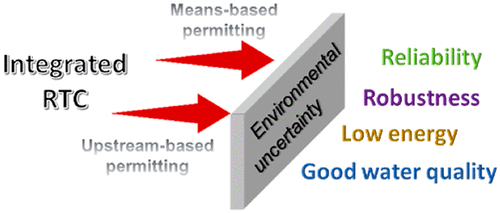当前位置:
X-MOL 学术
›
Environ. Sci. Technol.
›
论文详情
Our official English website, www.x-mol.net, welcomes your
feedback! (Note: you will need to create a separate account there.)
Regulatory Implications of Integrated Real-Time Control Technology under Environmental Uncertainty.
Environmental Science & Technology ( IF 10.8 ) Pub Date : 2020-01-09 , DOI: 10.1021/acs.est.9b05106 Fanlin Meng 1 , Guangtao Fu 1 , David Butler 1
Environmental Science & Technology ( IF 10.8 ) Pub Date : 2020-01-09 , DOI: 10.1021/acs.est.9b05106 Fanlin Meng 1 , Guangtao Fu 1 , David Butler 1
Affiliation

|
Integrated real-time control (RTC) of urban wastewater systems, which can automatically adjust system operation to environmental changes, has been found in previous studies to be a cost-effective strategy to strike a balance between good surface water quality and low greenhouse gas emissions. However, its regulatory implications have not been examined. To investigate the effective regulation of wastewater systems with this technology, two permitting approaches are developed and assessed in this work: upstream-based permitting (i.e., environmental outcomes as a function of upstream conditions) and means-based permitting (i.e., prescription of an optimal RTC strategy). An analytical framework is proposed for permit development and assessment using a diverse set of high performing integrated RTC strategies and environmental scenarios (rainfall, river flow rate, and water quality). Results from a case study show that by applying means-based permitting, the best achievable, locally suitable environmental outcomes (subject to 10% deviation) are obtained in over 80% of testing scenarios (or all testing scenarios if 19% of performance deviation is allowed) regardless of the uncertain upstream conditions. Upstream-based permitting is less effective as it is difficult to set reasonable performance targets for a highly complex and stochastic environment.
中文翻译:

环境不确定性下集成实时控制技术的法规含义。
以前的研究发现,城市废水系统的集成实时控制(RTC)可以自动调整系统操作以适应环境变化,这是一种经济高效的策略,可以在良好的地表水质量和低温室气体排放之间取得平衡。 。但是,其监管意义尚未得到审查。为了研究使用该技术对废水系统的有效调节,在这项工作中开发并评估了两种许可方法:基于上游的许可(即,环境结果作为上游条件的函数)和基于均值的许可(即,规定了排放许可)。最佳RTC策略)。建议使用一套高性能的综合RTC策略和环境方案(雨水,河流流量和水质)。案例研究的结果表明,通过采用基于手段的许可,可以在80%以上的测试方案(或如果性能偏差为19%的所有测试方案)中获得最佳可实现的,局部适合的环境结果(偏差为10%)。允许),而不考虑不确定的上游条件。基于上游的许可不太有效,因为很难为高度复杂和随机的环境设置合理的性能目标。无论不确定的上游条件如何,都可以在80%以上的测试方案(或所有测试方案中,如果允许性能偏差的19%)获得适合当地情况的环境结果(偏差为10%)。基于上游的许可不太有效,因为很难为高度复杂和随机的环境设置合理的性能目标。无论不确定的上游条件如何,都可以在80%以上的测试方案(或所有测试方案中,如果允许性能偏差的19%)获得适合当地情况的环境结果(偏差为10%)。基于上游的许可不太有效,因为很难为高度复杂和随机的环境设置合理的性能目标。
更新日期:2020-01-23
中文翻译:

环境不确定性下集成实时控制技术的法规含义。
以前的研究发现,城市废水系统的集成实时控制(RTC)可以自动调整系统操作以适应环境变化,这是一种经济高效的策略,可以在良好的地表水质量和低温室气体排放之间取得平衡。 。但是,其监管意义尚未得到审查。为了研究使用该技术对废水系统的有效调节,在这项工作中开发并评估了两种许可方法:基于上游的许可(即,环境结果作为上游条件的函数)和基于均值的许可(即,规定了排放许可)。最佳RTC策略)。建议使用一套高性能的综合RTC策略和环境方案(雨水,河流流量和水质)。案例研究的结果表明,通过采用基于手段的许可,可以在80%以上的测试方案(或如果性能偏差为19%的所有测试方案)中获得最佳可实现的,局部适合的环境结果(偏差为10%)。允许),而不考虑不确定的上游条件。基于上游的许可不太有效,因为很难为高度复杂和随机的环境设置合理的性能目标。无论不确定的上游条件如何,都可以在80%以上的测试方案(或所有测试方案中,如果允许性能偏差的19%)获得适合当地情况的环境结果(偏差为10%)。基于上游的许可不太有效,因为很难为高度复杂和随机的环境设置合理的性能目标。无论不确定的上游条件如何,都可以在80%以上的测试方案(或所有测试方案中,如果允许性能偏差的19%)获得适合当地情况的环境结果(偏差为10%)。基于上游的许可不太有效,因为很难为高度复杂和随机的环境设置合理的性能目标。









































 京公网安备 11010802027423号
京公网安备 11010802027423号